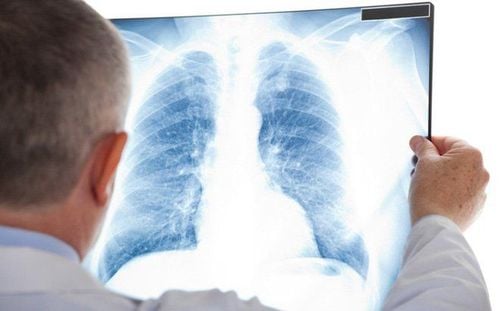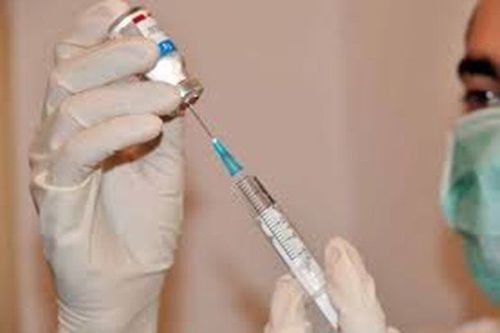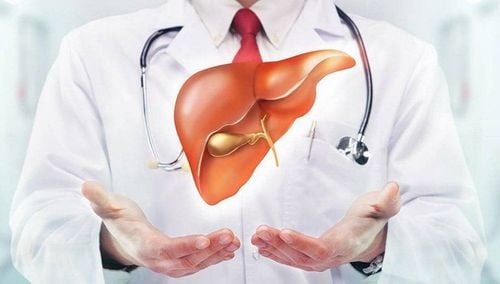This is an automatically translated article.
The article is written by Master, Doctor Ma Van Tham - Department of Pediatrics - Neonatology - Vinmec Phu Quoc International General Hospital.Diagnosis of wheezing children is mainly based on a thorough clinical examination of the thoracic-pulmonary region. If the clinical diagnosis is not clear, the doctor will perform other imaging tests, do laboratory tests or endoscopy to identify and rule out causes.
1. Diagnostic Imaging
An upright chest x-ray is necessary in children with unexplained wheezing.In most cases, a routine chest x-ray provides a good picture of the large airways, including the trachea and the two main bronchi. Films can often also help differentiate between diffuse and localized lesions. Diffuse lesions on film are seen in bronchiolitis, asthma, PCD, cystic fibrosis, aspiration pneumonia, heart failure. In contrast, local lesions show structural abnormalities or foreign bodies in the airway. Chest radiographs can also detect parenchymal lung disease and, in some cases, bronchiectasis.
In addition, routine chest x-ray may also reveal signs suggestive of a cardiovascular abnormality such as an enlarged heart shadow, raised pulmonary artery arc, pulmonary congestion, or other signs of heart failure. X-rays can also help detect mediastinal tumors, lymph nodes, or abnormal vascular loops.
On the other hand, chest x-ray is also useful in certain cases depending on the cause.
Computed tomography (CT) of the chest is indicated if the x-ray findings are not clear enough for diagnosis, especially high-resolution CT, which helps to evaluate the lung parenchyma, mediastinal tumors better.
Contrast-enhanced resonance imaging (MRI) is more significant in vascular malformations. Multi-probe CT is also useful in this setting.
Contrast esophagography helps to differentiate an aneurysm from gastroesophageal reflux, or other swallowing disorders. Video-enhanced esophagography is suggested for children younger than 2 years of age without neurological abnormalities with recurrent or persistent wheezing unresponsive to bronchodilators for dysphagia.

2. Testing
There are several tests that are helpful in the initial evaluation of a child with wheezing. In most cases, the probable diagnosis is suspected on the basis of history and physical examination. The role of laboratory tests, when indicated, is to confirm the diagnosis or rule out other less likely diagnoses. A complete blood count is important in patients with chronic or systemic symptoms and may show anemia, leukocytosis, or leukopenia. Eosinophilia suggests a possible allergic or parasitic process. Indications for further testing depend on the suspected diagnosis.2.1. Tests to assess the status of infection
Viral infections are an important cause of wheezing in children and are mediated through multiple mechanisms. The correlation between viral infection, wheezing, and the development of asthma in children is complex and varies with the age of the patient, the presence of atopy, and environmental factors.Viruses in the Paramyxoviridae family (eg, RSV and parainfluenza viruses) and the picornavirus family (eg, human rhinovirus) are important triggers of wheezing in young children. Metapneumovirus, another member of the Paramyxoviridae family, is a newly discovered pathogen that can lead to upper and lower respiratory tract infections and can cause wheezing. Therefore, viral tests may be useful in confirming the cause of wheezing in young children presenting with bronchiolitis. However, they are generally not recommended.
Sputum smear and culture can find etiologies such as atypical bacteria such as mycoplasma or fungi. Tuberculosis skin testing and specific serological tests should be performed if TB infection is suspected. Mycoplasma-specific serologic testing may be necessary in suspected cases.
2.2. Sweat chlorine test
The sweat chloride test allows clinicians to assess the physiological changes associated with cystic fibrosis and is indicated in children with chronic lung problems, including wheezing. It is expected that the majority of patients with cystic fibrosis will be diagnosed at birth by screening newborns with cystic fibrosis. However, false negatives can occur. Therefore, testing should be performed if cystic fibrosis is clinically suspected.The presence of diarrhea, growth retardation and/or clubbing raises suspicion of cystic fibrosis and requires further evaluation. This test is also recommended in patients with persistent or recurrent pulmonary symptoms unresponsive to asthma therapy, especially when wheezing is associated with chronic sputum cough. , as identifying a patient with cystic fibrosis has important implications for the patient, family, and future reproductive decisions. Sweat chloride testing should be performed in a facility with significant experience, and clinicians interpreting results should be aware of other conditions that lead to elevated chlorine levels in addition to cystic fibrosis. Positive results when chlorine concentration ≥ 60 mmol/l with sweat volume > 100mg.

2.3. Other tests
Depending on the cause, evaluate immune function if immunodeficiency is suspected. IgE can be elevated in allergic conditions or in asthma.3. Endoscopy of the airway
Bronchoscopy is a diagnostic tool used in patients with suspected airway foreign body, persistent wheezing, or unresponsiveness to conventional therapies. Rigid bronchoscopy is used in patients with sudden onset of wheezing and suspected airway foreign body. Flexible endoscopy can identify structural airway abnormalities, including airway cartilage abnormalities. Pharyngoscopy, which allows visualization of the vocal cords and larynx in the absence of lower airway endoscopy, is a less invasive alternative in infants and children with evidence of extrathoracic obstruction. . Bronchoscopy with endobronchial lavage (BAL) is useful in cases of suspected infection, aspiration, or interstitial lung disease.4. Evaluation of the possibility of gastroesophageal reflux disease (GERD)
Gastroesophageal reflux disease (GER) is a common cause of recurrent wheezing in children younger than 2 years of age. Therefore, 24-hour esophageal pH monitoring is suggested in young children with recurrent wheezing, particularly in children younger than 2 years of age with recurrent wheezing unresponsive to bronchodilators or inhaled or systemic glucocorticoids, because Symptoms of GER can be subtle in this age group. Evaluation of GER is also suggested for older children who have had a poor response to asthma therapies, especially if they have any suggestive symptoms. Symptoms may include excessive vomiting, coughing after meals, coughing and wheezing, and irritability manifested by crying or back pain.Diagnosis is confirmed by 24-hour esophageal pH assessment.

5. Pulmonary Function Measurements (PFTs)
In young children, PFT if present is helpful in assessing airway obstruction. Furthermore, this test can be used to quantify response to bronchodilators. Airway resistance and functional residual capacity can also be measured using gas dilution, which can help quantify airway obstruction and response to bronchodilators [5].In older, cooperators, PFT is helpful in determining the presence, extent and location of airway obstruction, as well as response to bronchodilators. Methacholine and exercise testing may confirm higher airway reactivity in patients in whom the diagnosis of asthma is in doubt.
6. Evaluation of response to trial treatment
For patients with diffuse wheezing, an inhaled bronchodilator test may be used to confirm reversible airway disease. However, a partial or negative reaction may not rule out asthma. Inflammation and edema of the respiratory mucosa may cause wheezing, associated with bronchospasm, especially in young children. Therefore, if bronchial asthma is suspected in a patient with persistent or recurrent wheezing, combine inhaled glucocorticoids and bronchodilators for at least two weeks (or 5-7 days of oral glucocorticoids if the patient has symptoms). more severe symptoms) can significantly improve symptoms and may help diagnose asthma. Further investigations should be performed if response to this therapy is inadequate or doubtful in a patient who has had a positive response to a bronchodilatorWheezing in children may be a sign signs of various clinical diseases. The cause should be sought and the clinical condition carefully evaluated before instituting treatment. Not all wheezing is a sign of asthma, but it can predict asthma risk in children who wheeze. Allergy testing in these young children can be of considerable value in finding avoidable allergens. Disease status as well as quality of life are improved if therapy is started at the appropriate time.
Please dial HOTLINE for more information or register for an appointment HERE. Download MyVinmec app to make appointments faster and to manage your bookings easily.














